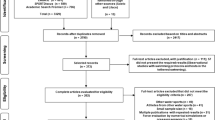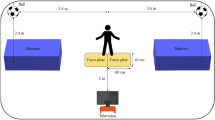Abstract
Purpose
This study presents a method to evaluate the efficacy of the start techniques’ biomechanics in swimming using a kinematic reference data-set.
Methods
The biomechanics of the start techniques was derived by the performances of ten regional swimmers using a marker-based stereoscopic approach. Three start techniques were analyzed: grab start, rear track start, and front track start. The kinematic reference data-set was compiled from data available from the literature in biomechanics of the high-level swimmers. The evaluating method was based on three parameters: (1) The horizontal component of the dive speed; (2) The angle between the line joining the center of mass of the swimmer with the intersection point of the pool-water plane and the pool edge plane; (3) The distance between the block and the center of mass of the swimmer.
Results
Differences (p < 0.05) in the block position during the start were found between the national swimmers and the references in grab start, front track start, and in rear track start. Before the dive, national swimmers jump up from the block in opposition to the high-level swimmers that drop from the block such as the literature revealed.
Conclusions
This study allows: (1) To formulate a model of comparative analysis of data from the literature; (2) To obtain a three-dimensional model of the swimmers using a handy low-cost stereoscopic system; (3) To compare different multi-dimensional biomechanical models designed to describe the diving task. This approach would provide an innovative tool to evaluate the efficacy of the start technique and to assist coaches and trainers to improve their training programs.




Similar content being viewed by others
References
Guimaraes A, Hay JG (1985) A mechanical analysis of the grab starting technique in swimming. Int J Sport Biomech 1(1):25–35
FINA (2013) Swimming rules 2013–2017 3 SW 4–10
Puel F, Morlier J, Avalos M, Mesnard M, Cid M, Hellard P (2012) 3D kinematic and dynamic analysis of the front crawl tumble turn in elite male swimmers. J Biomech 45(3):510–515. doi:10.1016/j.jbiomech.2011.11.043
Costill DL, Maglischo EW, Richardson AB (1992) Handbook of sports medicine and science. Swimming. Blackwell Scientific Publications, Oxford
Cossor JM, Mason BR (2001) Swim start performance at the Sydney 2000 Olympic Games. In: Blackwell JR, Sanders RH (eds) XIX International Symposium on Biomechanics in Sports. International Society of Biomechanics in Sport, San Francisco, pp 70–74
Cossor JM, Slawson SE, Justham LM, Conway PP, West AA (2010) The development of a component based approach for swim start analysis. In: Kjendlie PL, Stallman RK, Cabri J (eds) Biomechanics and medicine in swimming XI: XIth International Symposium for Biomechanics and Medicine. Swimming Norwegian School of Sport Science, Oslo, pp 59–61
Nützel W, Thoma B (1986) Measuring force-time variation in competitive racing dives. Rep Appl Meas 2(1):5–9
Maglischo EW (2003) Swimming fastest. Human Kinetics, Champaign
Kirner KE, Bock MA, Welch JH (1989) A comparison of four different start combinations. J Swim Res 5(2):5–11
Seifert L, Vantorre J, Lemaitre F, Chollet D, Toussaint HM, Vilas-Boas JP (2010) Different profiles of the aerial start phase in front crawl. J Strength Cond Res 24(2):507–516. doi:10.1519/JSC.0b013e3181c06a0e
Lewis S (1980) Comparison of five swimming starting techniques. Swim Tech 16(4):125–128
Welcher RL, Hinrichs RNG, Thomas R (2008) Front- or rear-weighted track start or grab start: which is the best for female swimmers? Sports Biomech 7(1):100–113. doi:10.1080/14763140701683247
Blanksby B, Nicholson L, Elliott B (2002) Biomechanical analysis of the grab, track and handle swimming starts: an intervention study. Sports Biomech 1(1):11–24. doi:10.1080/14763140208522784
Vilas-Boas JP, Cruz MJ, Sousa F, Conceicao F, Carvalho JM (2000) Integrated kinematic and dynamic analysis of two track-start techniques. In: Hong Y, Sanders R, P. JD (eds) XVIII International Symposium on Biomechanics in Sports. Department of Sports Science and Physical Education, University of Hong Kong. Hong Kong, pp 113–117
Vilas-Boas JP, Cruz MJ, Sousa F, Conceição F, Fernandes R, Carvalho JM (2003) Biomechanical analysis of ventral swimming starts: comparison of the grab start with two track-starts techniques. In: Chatard JC (ed) Biomechanics and medicine in swimming IX. Universitè de Saint-Etienne, Saint-Etienne, pp 249–254
Takeda T, Ichikawa H, Takagi H, Tsubakimoto S (2009) Do differences in initial speed persist to the stroke phase in front-crawl swimming? J Sport Sci 27(13):1449–1454. doi:10.1080/02640410903046228
Honda KE, Sinclair PJ, Mason BR, Pease DL (2010) A biomechanical comparison of elite swimmers start performance using the traditional track start and the new kick start. In: Kjendlie PL, Stallman RK, Cabri J (eds) Biomechanics and medicine in swimming XI. XIth International Symposium for Biomechanics and Medicine, Oslo, Swimming Norwegian School of Sport Science, pp 94–96
Murrell D, Dragunas A (2013) A comparison of two swimming start techniques from the omega OSB11. WURJ Health Natural Sci 3(1):1–6. doi:10.5206/wurjhns.2012-13.1
Honda K, Sinclair P, Mason B, Pease D (2012) The effect of starting position on elite swim start performance using an angled kick plate. In: Bradshaw EJ, Burnett A, Hume PA (eds) 30th Annual Conference of Biomechanics in Sports. ISBS, Melbourne, pp 72–76
Nomura T, Takeda T, Takagi H (2010) Influences of the back plate on competitive swimming starting motion in particular projection skill. In: Kjendlie PL, Stallman RK, Cabri J (eds) Biomechanics and medicine in swimming XI. XIth International Symposium for Biomechanics and Medicine, Swimming Norwegian School of Sport Science, Oslo, pp 135–137
Krüger T, Wick D, Hohmann A, El-Bahrawi M, Koth A (2003) Biomechanics of the grab and track start technique. In: Chatard JC (ed) Biomechanics and medicine in swimming IX. University of Saint-Etienne, Saint-Etienne, pp 219–224
Miller M, Allen D, Pein R (2003) A kinetic and kinematic comparison of the grab and track starts in swimming. In: Chatard JC (ed) Biomechanics and medicine in swimming IX. Université de Saint-Etienne, Saint-Etienne, pp 231–235
Holthe MJ, Mclean SP (2001) Kinematic comparison of grab and track starts in swimming. In: Blackwell JR, Sanders RH (eds) XIX International Symposium on Biomechanics in Sports San Francisco. International Society of Biomechanics in Sport, USA, pp 31–34
Benjanuvatra N, Edmunds K, Blanksby B (2006) Jumping Ability and Swimming Grab-Start Performance in Elite and Recreational Swimmers. Int J Aqua Res Edu 1:231–241
Bishop DC, Smith RJ, Smith MF, Rigby HE (2009) Effect of plyometric training on swimming block start performance in adolescents. J Strength Cond Res 23(7):2137–2143. doi:10.1519/JSC.0b013e3181b866d0
Breed RVP, Young WB (2003) The effect of a resistance training programme on the grab, track and swing starts in swimming. J Sports Sci 21(3):213–220. doi:10.1080/0264041031000071047
Vantorre J, Seifert L, Fernandes R, Vilas-boas JP, Chollet D (2010) Kinematical profiling of the front crawl start. Int J Sports Med 31(1):16–21. doi:10.1055/s-0029-1241208
Lee C-Y, Huang C-F, Lee C-W (2012) Biomechanical analysis of the grab and track swimming starts. In: Bradshaw EJ, Burnett A, Hume PA (eds) 30th Annual Conference on Biomechanics in Sports. ISBS, Melbourn, pp 369–372
Vantorre J, Seifert L, Fernandes RJ, Vilas-Boas JP, Chollet D (2010) Biomechanical Influence of Start Technique Preference for Elite Track Starters in Front Crawl. Open Sports Sci J 3:137–139
Yang ZR (2010) Machine learning approaches to bioinformatics. World scientific
Kahle W, Leonhardt H, Platzer W (1986) Color atlas and textbook of human anatomy. In: Locomotor system, 3rd edn, vol 1. Thieme, New York, pp 218–219
Winter DA (2009) Biomechanics and Motor Control of Human Movement, 4th edn. Wiley, Hoboken
Bouguet JV (2000) Camera calibration toolbox for Matlab. http://www.vision.caltech.edu/bouguetj/calib_doc/
Mariottini GL, Prattichizzo D (2005) EGT: a toolbox for multiple view geometry and visual servoing. IEEE Robot Autom Mag 3(12):26–39. doi:10.1109/MRA.2005.1577022
Silaghi M-C, Plänkers R, Boulic R, Fua P, Thalmann D (1998) Local and global skeleton fitting techniques for optical motion capture. In: Magnenat-Thalmann N, Thalmann D (eds) Modelling and motion capture techniques for virtual environments. Lecture notes in computer science, vol 1537. Springer, Berlin, Heidelberg, pp 26–40. 10.1007/3-540-49384-0_3
Härtel T, Schleichardt A (2008) Evaluation of start techniques in sports swimming by dynamics simulation (P18). In: The engineering of sport 7. Springer, Paris, pp 89–96. doi:10.1007/978-2-287-99054-0_11
Fu T-c (2011) A review on time series data mining. Eng Appl Artif Intell 24(1):164–181. doi:10.1016/j.engappai.2010.09.007
Esling P, Agon C (2012) Time-series data mining. ACM Comput Surv 45(1):1–34. doi:10.1145/2379776.2379788
Hutter M, Zaffalon M (2005) Distribution of mutual information from complete and incomplete data. Comput Stat Data Anal 48(3):633–657. doi:10.1016/j.csda.2004.03.010
Janušonis S (2009) Comparing two small samples with an unstable, treatment-independent baseline. J Neurosci Methods 179(2):173–178. doi:10.1016/j.jneumeth.2009.01.017
Arellano R, Pardillo S, de la Fuente B, Garcia F (2000) A system to improve the swimming start technique using force recording, timing and kinematic analyses. In: Hong Y, Johns DP, Sanders R (eds) XVIII International Symposium on Biomechanics in Sports. Department of Sports Science and Physical Education, Chinese University of Hong Kong. Hong Kong, pp 609–613
Benjanuvatra N, Lyttle A, Blanksby B, Larkin D (2004) Force development profile of the lower limbs in the grab and track start in swimming. In: Lamontagne M, Robertson DGE, Sveistrup H (eds) XXII International Symposium on Biomechanics in Sports. Faculty of Health Sciences, University of Ottawa. Ottawa, pp 399–402
Acknowledgments
The Authors thank Dr. Elena Francioni for her contribution in the experimental stage of this study.
Conflict of interest
Donato Formicola and Alberto Rainoldi declare that there are no conflicts of interest.
Author information
Authors and Affiliations
Corresponding author
Rights and permissions
About this article
Cite this article
Formicola, D., Rainoldi, A. A kinematic analysis to evaluate the start techniques’ efficacy in swimming. Sport Sci Health 11, 57–66 (2015). https://doi.org/10.1007/s11332-014-0207-8
Received:
Accepted:
Published:
Issue Date:
DOI: https://doi.org/10.1007/s11332-014-0207-8




